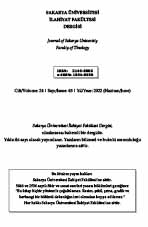Mevlevî Usulü Teravih: Çeşitlilik Bağlamında Kasımpaşa Mevlevîhânesi’nden Teravihe Mahsus Âyin Mecmuası
Mawlawī Style Tarāwīḥ: Āyīn Mecmua for Tarāwīḥ from Kasımpaşa Mawlawī Lodge in the Context of Diversity
Author(s): Selman BenlioğluSubject(s): Music, Theology and Religion, Islam studies
Published by: Sakarya üniversitesi
Keywords: Turkish Religious Music; Mawlawī rite; Tarāwīḥ; Ramadan; Kasımpaşa Mawlawī Lodge;
Summary/Abstract: The part of the four-rakat of the tarāwīḥ prayer, which is specific worship during the month of Ramadan, is called tarwīḥa. The tradition of performing the recitation of the Qurʾān in different maqāms at each tarwīḥa and reciting various hymns and ṣalawāts between the prayers is called the tarāwīḥ tartibi (order of tarāwīḥ). There is no detailed information about the beginning and development of this tradition. Some compilations were prepared at the beginning of the 20th century. In these compilations, five hymns were selected for each night of the month of Ramadan, and their lyrics were written. Although it is not found in the primary sources, the narration that the tarāwīḥ tartibi was arranged by Buhūrīzāde Muṣṭafā ʿIṭrī (d. 1712) is dominant in the literature. In addition, the practice of tarāwīḥ tartibi has been called "Enderūn style tarāwīḥ" in recent years. Again, this definition, which is not based on a historical record, emphasizes that the practice originates from the Ottoman court.
Journal: Sakarya Üniversitesi İlahiyat Fakültesi Dergisi (SAUIFD)
- Issue Year: 24/2022
- Issue No: 45
- Page Range: 117-140
- Page Count: 24
- Language: Turkish

